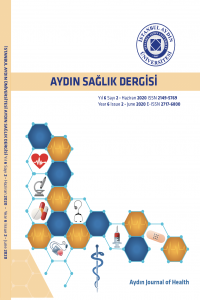Serebral Palsili Çocuklarda Üst Ekstremite Fonksiyonelliğinin İncelenmesi
Serebral Palsi, Üst Ekstremite, Fonksiyonel Değerlendirme
___
- [1] Rosenbaum P, Paneth N, Leviton A, Goldstein M, Bax M, Damiano D, et al. A report: the definition and classification of cerebral palsy. Dev Med Child Neurol Suppl 2007; 109:8-14. [2] Mark T. Jobe. Campbell's Operative Orthopaedics. 12. Edition. Mosby; 2013, 3535-3554. [3] Sakzewski L, Ziviani J, Boyd R. Systematic review and metaanalysis of therapeutic management of upper-limb dysfunction in children with congenital hemiplegia. Pediatrics, 2009; 123 6: e1111-e1122. doi:10.1542/peds.2008-3335. [4] Kinnucan E, Van Heest A & Tomhave W. Correlation of motor function and stereognosis impairment in upper limb cerebral palsy. Journal of Hand Surgery 2010; 35(8), 1317–1322. [5] Himmelmann K, Beckung E, Hagberg G & Uvebrant P. Gross and fine motor function and accompanying impairments in cerebral palsy. Developmental Medicine & Child Neurology 2006; 48, 417–423. [6] DeLuca PA. The Musculoskeletal management of children with cerebral palsy. Pediatric Clinics of North America 1996; 43: 1135- 1150. [7] Flett PJ. Rehabilitation of spasticity and related problems in childhood cerebral palsy. J Paediatr Child Health 2003; 39:6-14. [8] Schneider JW, Gurucharri LM, Gutierrez AL, Gaebler-Spira DJ. Health-related quality of life and functional outcome measures for children with cerebral palsy. Dev Med Child Neurol. 2001; 43(9):601- 608. [9] Williams LA. A suggested method for evaluating proprioception, stereognosis, and body scheme in adult patients with cerebral vascular accident for occupational therapists. (Master’s project). San Jose state College, 1964. [10] Muen WJ, Bannister CM. Hand function in subject with spina bifida. Eur. J. Pediatr.Surg 1997; 7(1):18-22. [11] Hwang R, Kentish M, Burns Y. Hand positioning sense in children with spina bifida myelomeningocele. Australian Journal of Physiotherapy 2002; 48: 17-22. [12] Green WT, Banks HH. Flexor carpi ulnaris transplant and its use in cerebral palsy. J Bone Joint Surg Am 1962; 44:1343-52. Aydın Sağlık Dergisi - Yıl 2 Sayı 2 - 2016 (37-50) 49 [13] Samilson RL, Morris JM. Surgical improvement of the cerebralpalsied upper limb: Electromyographic studies and results of 128 operations. J Bone Joint Surg Am. 1964; 46:1203–16. [14] Jansen J, Taudorf K, Pedersen H, et al. Upper extremity function in spina bifida. Child's Nervous System 2005; 7(2): 67-71. [15] Muen WJ, Bannister CM. Hand function in subject with spina bifida. Eur. J. Pediatr.Surg 1997; 7(1):18-22. [16] Wai E, Young N, Feldman B. The relationship between function and self-perception and spinal deformity. J Pediatr Orthop 2005; 25:64–69. [17] Chin TYP, Duncan JA, Johnstone BR, Graham HK. Management of the upper limb in cerebral palsy. J Pediatr Orthop 2005;14:389. [18] Van Heest AE, Ramachandran V, Stout J, et al. Quantitative and qualitative functional evaluation of upper extremity tendon transfers in spastic hemiplegia caused by cerebral palsy. J Pediatr Orthop 2008; 28:679. [19] Langan J, Kern K, Hurvitz E, Brown S. Upper-limb position sense deficits in adults with cerebral palsy. Am. J. Phys. Med. Rehabil. 2014; Vol. 93, No. 9 774 - 781. [20] Green D, Schertz M, Gordon A, Moore A, et al. A multi-site study of functional outcomes following a themed approach to hand-arm bimanual intensive therapy for children with hemiplegia. Department of Occupational Therapy, Faculty of Medicine, Tel Aviv University, Israil 2013. [21] Crajé C, Aarts P, Nijhuis-van der Sanden M & Steenbergen B. Action planning in typically and atypically developing children (unilateral cerebral palsy). Research in Developmental Disabilities 2010; 31(5), 1039-1046. [22] Bolanos AA, Bleck EE, Firestone P, et al. Comparison of stereognosis and two-point discrimination testing of the hands of children with cerebral palsy. Developmental Medicine & Child Neurology. 1989; 31: 371–376. [23] Gordon AM, Duff SV. Relation between clinical measures and fine manipulative control in children with hemiplegic cerebral palsy. Developmental Medicine & Child Neurology 1999; 41: 586–91. [24] Wilson BC, Wilson JJ. Sensory and perceptual functions in the cerebral palsied. II. Stereognosis. Journal of Nervous and Mental Disease. 1967; 145:61–68. [25] Van Heest AE, House J, Putnam M. Sensibility deficiencies in the hands of children with spastic hemiplegia. Journal of Hand Surgery – American Volume. 1993; 18:278–81. [26] Krumlinde-Sundolm L, Elliasson A. Comparing tests of tactile sensibility: aspects relevant to testing children with spastic hemiplegia. Developmental Medicine & Child Neurology. 2002; 44: 604–612.
- ISSN: 2149-5769
- Yayın Aralığı: Yılda 3 Sayı
- Başlangıç: 2015
- Yayıncı: İstanbul Aydın Üniversitesi
Sağlk Hizmetleri Meslek Yüksekokulu Öğrencilerinin Kariyer Eğilimi
Transrektal Ultrasonografi Eşliğinde Prostat Biyopsisi ve Hemşirelik Yaklaşımı
Serebral Palsili Çocuklarda Üst Ekstremite Fonksiyonelliğinin İncelenmesi
Hasan Atacan TONAK, Mustafa Can KILIÇ, Özge KARADENİZ YENİLMEZ, Ali KİTİŞ
Merve PEHLİVAN, İndrani KALKAN
Santral Venöz Kateterizasyon ve Venöz Tromboemboli Riski
Döndü GENÇ MORALAR, Ülkü AYGEN TÜRKMEN, Ayşin ERSOY, Özgül KIRBAÇ
Mandibular Malpozisyon Olgusunda Fiberoptik Intubating LMA-C Trach Kullanm
Ülkü AYGEN TÜRKMEN, Deniz KARA, Döndü GENÇ MORALAR, Esra TEKİN, Erdinç DENİZLİ, Murat MEHEL
Hüseyin Ozan TEKİN, Elif Ebru ALTUNSOY, Tuğba MANİCİ, Ümit KARA, Bariş ÇAVLI
